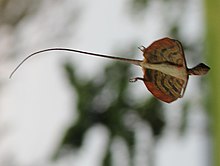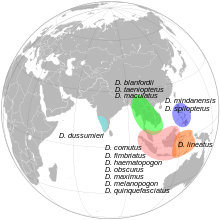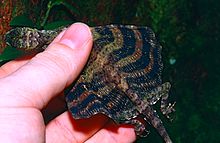| Draco | |
|---|---|

| |
| D. taeniopterus in mid-glide, on Bulon Island, Thailand | |

| |
| Male D. spilonotus extending the dewlap (throat flap) and patagia ("wings") in Sulawesi, Indonesia | |
| Scientific classification | |
| Domain: | Eukaryota |
| Kingdom: | Animalia |
| Phylum: | Chordata |
| Class: | Reptilia |
| Order: | Squamata |
| Suborder: | Iguania |
| Family: | Agamidae |
| Subfamily: | Draconinae |
| Genus: | Draco Linnaeus, 1758 |
| Species | |
|
41 species (see text) | |

| |
Draco is a genus of agamid lizards that are also known as flying lizards, flying dragons or gliding lizards. These lizards are capable of gliding flight via membranes that may be extended to create wings (patagia), formed by an enlarged set of ribs. They are arboreal insectivores.
While not capable of powered flight they often obtain lift in the course of their gliding flights. Glides as long as 60 m (200 ft) have been recorded, over which the animal loses only 10 m (33 ft) in height which makes for a glide ratio of 6:1. This is done by a lizard of only around 20 cm (7.9 in) in total length, tail included. They are found across Southeast Asia and Southern India and are fairly common in forests, areca gardens, teak plantations and shrub jungle.
History of discovery

Carl Linnaeus described the genus in 1758, with the type species being Draco volans. The name of the genus is from the Latin term for dragons of mythology. In the early and mid 20th century, there was controversy about their gliding capabilities, with some authors suggesting that the patagia were solely for display, but research in the late 1950s firmly established the gliding function of the patagia.
Distribution
Species of Draco are widely distributed in the forests of Southeast Asia, with one species, Draco dussumieri, inhabiting Southern India.
Habitat and ecology
Members of Draco are primarily arboreal, inhabiting tropical rainforests, and are almost never found on the forest floor. They are insectivorous, primarily feeding on eusocial insects such as ants and termites. The colour of the patagium is strongly correlated to the colour of falling leaves in their range, which complements their cryptic camouflage resembling tree bark; both are likely to be camouflage against predatory birds.
Gliding


The lizards are well known for their "display structures" and ability to glide long distances using their wing-like, patagial membranes supported by elongated thoracic ribs to generate lift forces. The hindlimbs in cross section form a streamlined and contoured airfoil, and are also probably involved in generating lift. Gliding is both used to escape predators, and as the primary means of moving through their forest habitat. The folding and unfolding of the membrane is controlled by the iliocostalis and intercostal muscles, which in other lizards are used to control breathing. At takeoff, the lizard jumps and descends headfirst, orientating itself so that the underside of the body is parallel to the ground. During flight, the back arches, forming the patagium into a cambered surface, and the forelimbs grab the front of the patagium, forming a straight front edge to the aerofoil. The forelimbs are used to manipulate the patagium in order to adjust the trajectory during flight. Maximum gliding speeds have been found to be between 5.2 and 7.6 metres per second, depending on the species. During the landing process, the glide is mostly horizontal. Immediately before landing, the forelimbs release the patagium. The landing is forefeet-first, followed by hindfeet. The shape of the gliding membrane does not correlate with body size, meaning the larger species have proportionately less lift-generating surface area and consequently higher wing loading.
Life history
Draco lizards are highly territorial, with the home range consisting of one or a few trees. The trees are actively guarded by males, with territory-less males searching the forest landscape in search of vacant areas. Experimental studies have determined that suitable unoccupied territories were claimed within a few hours of the removal of a dominant male. Females move freely through the territories. The patagium is used as a display structure during courtship and territorial disputes between rival males, alongside the opening of a brightly-colored dewlap that contrasts with their camouflaged body scalation. The dewlap is translucent, and deliberately orientated perpendicular to the orientation of the sun during display in order to enhance visibility. Draco is sexually dimorphic, with females being larger than males. The only time a female flying lizard ventures to the ground is when she is ready to lay her eggs. She descends the tree she is on and makes a nest hole by forcing her head into the soil. She then lays a clutch of 2–5 eggs before filling the hole and guards the eggs for approximately 24 hours, but then leaves and has nothing more to do with her offspring.
Phylogenetics
Within Agamidae, Draco is a member of the subfamily Draconinae. Within Draconinae, Draco is most closely related to the genera Japalura and Ptyctolaemus.
Species



The following 41 species are recognized:
- Draco abbreviatus Hardwicke & Gray, 1827 – Singapore flying dragon
- Draco beccarii W. Peters & Doria, 1878
- Draco biaro Lazell, 1987 – Lazell's flying dragon
- Draco bimaculatus Günther, 1864 – two-spotted flying lizard
- Draco blanfordii Boulenger, 1885 – Blanford's flying dragon, Blanford’s flying lizard, Blanford's gliding lizard
- Draco boschmai Hennig, 1936
- Draco caerulhians Lazell, 1992
- Draco cornutus Günther, 1864
- Draco cristatellus Günther, 1872 – crested flying dragon
- Draco cyanopterus W. Peters, 1867
- Draco dussumieri A.M.C. Duméril & Bibron, 1837 – Indian flying lizard, Western Ghats flying lizard, southern flying lizard
- Draco fimbriatus Kuhl, 1820 – fringed flying dragon, crested gliding lizard
- Draco formosus Boulenger, 1900 – dusky gliding lizard
- Draco guentheri Boulenger, 1885 – Günther's flying lizard, Guenther's flying lizard
- Draco haematopogon Gray, 1831 – red-bearded flying dragon, yellow-bearded gliding lizard
- Draco indochinensis M.A. Smith, 1928 – Indochinese flying lizard, Indochinese gliding lizard
- Draco iskandari McGuire et al., 2007
- Draco jareckii Lazell, 1992
- Draco lineatus Daudin, 1802 – lined flying dragon
- Draco maculatus (Gray, 1845) – spotted flying dragon
- Draco maximus Boulenger, 1893 – great flying dragon, giant gliding lizard
- Draco melanopogon Boulenger, 1887 – black-bearded gliding lizard, black-barbed flying dragon
- Draco mindanensis Stejneger, 1908 – Mindanao flying dragon, Mindanao flying lizard
- Draco modiglianii Vinciguerra, 1892 – lined flying dragon
- Draco norvillii Alcock, 1895 – Norvill's flying lizard
- Draco obscurus Boulenger, 1887 – dusky gliding lizard
- Draco ornatus (Gray, 1845) – white-spotted flying lizard
- Draco palawanensis McGuire & Alcala, 2000
- Draco punctatus Boulenger, 1900 – punctate flying dragon
- Draco quadrasi Boettger, 1893 – Quadras's flying lizard
- Draco quinquefasciatus Hardwicke & Gray, 1827 – five-lined flying dragon, five-banded gliding lizard
- Draco reticulatus Günther, 1864
- Draco rhytisma Musters, 1983
- Draco spilonotus Günther, 1872 – Sulawesi lined gliding lizard
- Draco spilopterus Wiegmann, 1834 – Philippine flying dragon
- Draco sumatranus Schlegel, 1844 – common gliding lizard
- Draco supriatnai McGuire et al., 2007
- Draco taeniopterus Günther, 1861 – Thai flying dragon, barred flying dragon, barred gliding lizard
- Draco timoriensis Kuhl, 1820 – Timor flying dragon
- Draco volans Linnaeus, 1758 – common flying dragon
- Draco walkeri Boulenger, 1891
Nota bene: a binomial authority in parentheses indicates that the species was originally described in a genus other than Draco.
Similar prehistoric reptiles

Several other lineages of reptile known from the fossil record have convergently evolved similar gliding mechanisms consisting of a patagium or plate flanking the torso; the weigeltisaurids are the oldest of these, living in the Late Permian from around 258 to 252 million years ago. Other lineages include the Triassic kuehneosaurids and Mecistotrachelos, and the Cretaceous lizard Xianglong.
See also
- Flying and gliding animals
- Chrysopelea gliding snake
References
- ^ Draco at the Reptarium.cz Reptile Database. Accessed 8 June 2021.
- ^ Piper, Ross (2007). 'Extraordinary Animals: An Encyclopedia of Curious and Unusual Animals'. Santa Barbara, California: Greenwood Press.
- ^ McGuire, J. A.; Dudley, R. (2011-07-28). "The biology of gliding in flying lizards (genus Draco) and their fossil and extant analogs". Integrative and Comparative Biology. 51 (6): 983–990. doi:10.1093/icb/icr090. PMID 21798987.
- Honda, Masanao; Ota, Hidetoshi; Kobayashi, Mari; Nabhitabhata, Jarujin; Yong, Hoi-Sen; Hikida, Tsutomu (June 1999). "Phylogenetic Relationships of the Flying Lizards, Genus Draco (Reptilia, Agamidae)". Zoological Science. 16 (3): 535–549. doi:10.2108/zsj.16.535. hdl:2241/104136. ISSN 0289-0003. S2CID 59043102.
- Mori, Akira; Hikida, Tsutomu (1994-02-01). "Field Observations on the Social Behavior of the Flying Lizard, Draco volans sumatranus, in Borneo". Copeia. 1994 (1): 124. doi:10.2307/1446678. JSTOR 1446678. Archived from the original on 2021-06-26. Retrieved 2021-06-01.
- Klomp, D. A.; Stuart-Fox, D.; Das, I.; Ord, T. J. (December 2014). "Marked colour divergence in the gliding membranes of a tropical lizard mirrors population differences in the colour of falling leaves". Biology Letters. 10 (12): 20140776. doi:10.1098/rsbl.2014.0776. PMC 4298188. PMID 25540157.
- Herre, Albert W. (1958). "On the gliding of flying lizards, genus Draco ". Copeia. 1958 (4): 338–339. doi:10.2307/1439979. JSTOR 1439979.
- ^ Dehling, J. Maximilian (2017-12-13). "How lizards fly: A novel type of wing in animals". PLOS ONE. 12 (12): e0189573. Bibcode:2017PLoSO..1289573D. doi:10.1371/journal.pone.0189573. PMC 5728497. PMID 29236777.
- McGuire, Jimmy A. (February 2003). "Allometric prediction of locomotor performance: an example from Southeast Asian flying lizards". The American Naturalist. 161 (2): 337–349. doi:10.1086/346085. PMID 12675377. S2CID 29494470. Archived from the original on 2021-06-02. Retrieved 2021-06-02.
- Klomp, Danielle A.; Stuart-Fox, Devi; Das, Indraneil; Ord, Terry J. (February 2017). "Gliding lizards use the position of the sun to enhance social display". Biology Letters. 13 (2): 20160979. doi:10.1098/rsbl.2016.0979. PMC 5326517. PMID 28179410.
- Srichairat, Nattawut; Duengkae, Prateep; Jantrarotai, Pattanee; Chuaynkern, Yodchaiy (March 2016). "Sexual dimorphism in the spotted flying lizard Draco maculatus (Gray, 1845) (Squamata: Agamidae) from Thailand". Agriculture and Natural Resources. 50 (2): 120–124. doi:10.1016/j.anres.2015.08.002.
- Husak, Jerry F.; Mcguire, Jimmy Adair (2014). "Does 'gliding while gravid' explain Rensch's rule in flying lizards?". Biological Journal of the Linnean Society. 113: 270–282. doi:10.1111/bij.12319. "Similarly, in some Draco it has been suggested that females have larger heads for their body size than males to counterbalance an increased weight burden that is displaced posteriorly during gravidity."
- Wang, Kai; Che, Jing; Lin, Simin; Deepak, V; Aniruddha, Datta-Roy; Jiang, Ke; Jin, Jieqiong; Chen, Hongman; Siler, Cameron D (2019-01-01). "Multilocus phylogeny and revised classification for mountain dragons of the genus Japalura s.l. (Reptilia: Agamidae: Draconinae) from Asia". Zoological Journal of the Linnean Society. 185 (1): 246–267. doi:10.1093/zoolinnean/zly034. ISSN 0024-4082.
- "Draco ". Dahms Tierleben. www.dahmstierleben.de.
- Beolens, Bo; Watkins, Michael; Grayson, Michael (2011). The Eponym Dictionary of Reptiles. Baltimore: Johns Hopkins University Press. xiii + 296 pp. ISBN 978-1-4214-0135-5. (Draco beccarii, p. 21).
Further reading
- Goin CJ, Goin OB, Zug GR (1978). Introduction to Herpetology, Third Edition. San Francisco: W.H. Freeman & Company. xi + 378 pp. ISBN 0-7167-0020-4. (Genus Draco, pp. 41, 86, 112, 279, 288).
- Inger RF (1983). Morphological and ecological variation in the flying lizards (Genus Draco). Chicago: Field Museum of Natural History. (Fieldiana Zoology, New Series, No. 18). 33 pp.
- Linnaeus C (1758). Systema naturæ per regna tria naturæ, secundum classes, ordines, genera, species, cum characteribus, differentiis, synonymis, locis. Tomus I. Editio Decima, Reformata. Stockholm: L. Salvius. 824 pp. (Genus Draco, p. 199).
- Phillips, Walter Alison (1911). "Dragon" . Encyclopædia Britannica. Vol. 8 (11th ed.). pp. 466–468.
- Read on vastlyimportant
| Taxon identifiers | |
|---|---|
| Draco | |